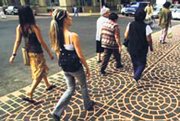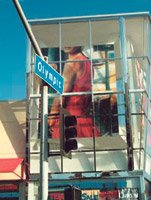Fashion District Thrives as Economic Engine
The Los Angeles Fashion District is celebrating its slightly more than 10- year anniversary with plans to expand its boundaries to the east and build on its claim as the hub of Southern California’s fashion industry.
The Fashion District was formed in 1996 as a business-improvement district (BID) that is financially supported by property owners to keep the area safe, clean and business friendly. It was the first BID in Los Angeles and has set the tempo for other business-improvement districts that span Southern California from Santa Monica to Old Pasadena.
When the Los Angeles Fashion District was formed in 1996, it encompassed 56 blocks. By 2004, it had expanded to 94 blocks, and by 2008 it could grow again when the BID has to be renewed with the consent of property owners.
“Every time the BID has been renewed, the boundaries have grown,” said Steve Gibson, president of Urban Place Consulting Group, which is advising the L.A. Fashion District on its BID renewal. He noted there have been requests by areas south and west of the Fashion District to be included in the renewed BID. But the Fashion District, headed by Executive Director Kent Smith, is looking at expanding to the east, where most of the new fashion businesses have popped up.
That was the message at the Fashion District’s annual meeting May 31 at the California Market Center, where BID members got a report about the BID’s economic impact.
Nancy Sidhu, vice president and senior economist at the Los Angeles County Economic Development Corp., who helped prepare the report, said the district’s 4,375 businesses have annual revenues of $3.7 billion and maybe $2 billion more in unrecorded transactions that take place on the street or are not tracked by local financial institutions.
The Fashion District’s economic impact goes beyond its boundaries, she added, because most businesses order supplies and goods from outside their immediate working area. “The $3.7 billion in revenues taken in by the District means there are $5.7 billion earned directly or indirectly throughout Los Angeles County,” Sidhu said.
The Fashion District is definitely the hub of the local fashion industry. While the area has only 2 percent of the county’s businesses, it houses 41 percent of the apparel wholesalers in Los Angeles, 31 percent of apparel retailers, 17 percent of fashion designers and 13 percent of the textile and textile products manufacturing.
The area’s five market weeks and Los Angeles Fashion Week draw 57,000 buyers and exhibitors a year to the California Market Center, The New Mart, the Cooper Design Space, the Gerry Building and Designers &Agents, a trade show, Sidhu said.
Los Angeles has surpassed New York City as the apparel-manufacturing center of the country. And it is on an even-par with New York City as a major apparel wholesaler.
In 1990, Los Angeles and New York City each had about 90,000 garment workers. By 2005, Los Angeles had 61,500 workers and New York City had only 29,000.
Condo commanders While business has grown inside the District, so have the flurry of condo conversions that are turning the Los Angeles Fashion District into a place that actually has some pedestrian traffic in the evening.
But new residents also pose a problem in getting the Fashion District BID renewed before it expires at the end of 2008. That’s because the BID renewal must be approved by a majority of the property owners in the area.
Convincing condo owners they should paymight be tricky, experts warned.
If a BID is approved, then all property owners are assessed a fee to pay for the various operations that make the District a clean and safe place.
In 2006, the L.A. Fashion District’s budget was $3.6 million.
That paid for the more than 30 security officers on bicycles who patrol seven days a week. It also paid for workers to clean 31.6 million square feet of sidewalks in the BID whose boundaries are Seventh Street to the north, the Santa Monica Freeway to the south, Spring and Main streets to the west and San Pedro Street to the east. They also collected more than six tons of trash a day and removed graffiti.
While the BID has been a huge success, there still are more things that need to be done, Sidhu said.
The district needs to repair and update its infrastructure as well as upgrade its streetscape. “A lot has been improved,” Sidhu said. “But buyers and retail consumers will appreciate the difference and be more comfortable and more likely to come back.”
She also suggested the Fashion District do more marketing and promotion to city residents about the shopping opportunities in the area.
Parking is still an issue, although Sidhu said it isn’t just a matter of more parking.
Something has to be done to make it easier to find that parking. She suggested more signs.























